ISSN ONLINE(2278-8875) PRINT (2320-3765)
ISSN ONLINE(2278-8875) PRINT (2320-3765)
Soumendu Bhattacharjee1, Arghadeep Mazumder2, Zinkar Das3, Lopamudra Kumar4, Kadambini Shree5, Dr.Biswarup Neogi6
|
| Related article at Pubmed, Scholar Google |
Visit for more related articles at International Journal of Advanced Research in Electrical, Electronics and Instrumentation Engineering
Cardiovascular diseases introducing eco-cardiovascular graphic is ever growing field. The occurrence of heart diseases mainly depends upon unhealthy lifestyle like smoking, alcoholism and taking unhealthy food like red meat, egg etc. Several diseases is caused due to the abnormal pumping of heart or occurrence of any blockage in the chamber of heart, like mitral stenosis, mitral valve regurgitation, aortic stenosis, aortic regurgitation, and tricuspid stenosis, tricuspid regurgitation, rheumatic heart diseases, asthma, myocardial infraction, ischemic heart disease and also heart attack may occur. It has been seen here that preliminary study of ECG signal, change of wavelets helps to gather idea about various heart diseases. Prevention from this type of diseases can be taken from the decision table attached below. Preliminary idea about medicines, which should be taken for this type of heart abnormality, can also be made of by the medicinal approach introduced here.
Keywords |
| Cardiovascular disease, ECG, Hypertension, Diabetes, Cholesterol, Obesity, Physical inactivity. |
INTRODUCTION |
| A view of the heart’s activity, which is generated during the cardiac cycle is provided by electrocardiogram (ECG) and is measured with external electrodes. Its medical importance in cardiology is well established, being used for example to determine heart rate and investigate abnormality of heart rhythm .In applications for ECG signal processing the useful signals are superimposed by different components[1].Sachem Sing et all using Pan-Tomkins algorithm worked on pattern analysis of different ECG signals. As the ECG signal is non-stationary and pseudo periodic in nature, the waveform of it changes with respect to time [2]. A great job on the application of wavelet techniques has been done by Prof. Nagendra H et al. The Quality of life of patients from chronic diseases has been greatly improved by the monitoring of biomedical signals. This assignment is made simpler by the use of wireless sensors within a body area network (BAN) [3]. An immense job was worked on Feature Extraction Techniques by Dieted Platelet al. An enormous job on ECG signal and monitoring was also done by Wyatt potter et al on January 2001. Mohammad Abo- Zahhad et al also worked on ECG signal compression techniques .The ECG signal is very sensitive in nature, and even if small quantity of noise is mixed with the signal the original characteristics of the signal changes [4]. An immense job on filtering techniques of ECG signal is also established by Dr. M.K. Soniet al. Research on compression of ECG signal using video coded technology in “JBISE” book which was published in the year of 2008 was diligently executed by Mr. Douche et al. Another research on filtering of ECG signal using Butterworth was published by Bharti Sales kart and Dr. A.K. Adjani on April 2002. Several researches, e.g. research on detection of ECG signal wavelet and wavelet compression of ECG signal using SPHIT algorithm was thoroughly executed by Md. Tanveer Hasten al and Mohammad Pohang al. Detection of QRS complex plays an important role in ECG signal [5]. “Automation detection” using discrete wavelet transform was processed by Venire k et al. And interpretation of ECG signal with multi-layer neutral network was processed by D.O strafe. |
RESEARCH AND COLLECT IDEA |
A. The Reasons for Cardiovascular Diseases: |
| Cardiovascular disease is so hazardous that the essential pumping function of the heart can be easily affected by it. Generally it consists of three main forms- Congenital, Coronary and Cardiomyopathy. No specific reasons are there behind it. Due to unhealthy food choices and affluent lifestyle these diseases are occurred. The major risk factors of cardiovascular diseases are given below- |
1. High blood cholesterol: |
| High blood cholesterol is one of the major risk factors. Cholesterol, which is nothing but a fat-like substance and the chances of disease are increased by a condition, which is known as risk factor. The tendency of building up wall in our arteries has been easily strengthen up by the presence of excess cholesterol in our blood. Later as a result of this buildup the "hardening of the arteries" is occurred. So the arteries become narrower or thinner and the flow of blood is slowed down. Oxygen is carried by blood to the heart, and if enough oxygen mixed blood has not been received by the heart, chest pain is occurred. When the supply of blood to a portion of heart is broken off by a blockage, as a result heart attack occurs [6]. In the fig 01 it is shown that how the cholesterol from both sources can from plaque in our body vessels [19]. |
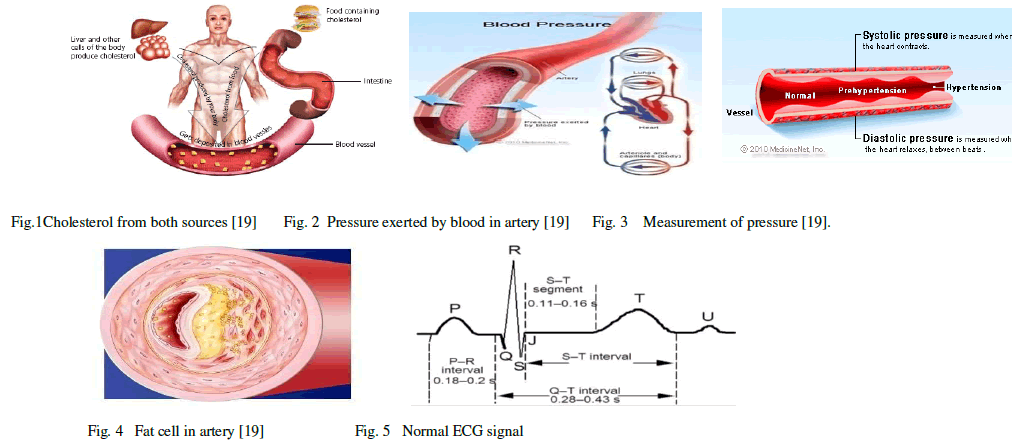 |
2. Hypertension (High Blood Pressure): |
| The chance of cardiovascular diseases is furthermore increased by Hypertension. The probability of high blood pressure is amplified by daily smoking and alcoholism and hence the possibility of heart attack, stroke and even death is increased. Coronary heart diseases, heart failure, stroke, kidney failure etc is followed by high blood pressure [7] [19]. "Blood pressure" is the force of blood which is pumped by the heart, pushing against the walls of the arteries. If this pressure rises and stays high for a long time, body can be damaged by it. The force of blood into the arteries during the pumping is enough to push the blood to each organ from top to bottom of the body. Blood pressure can be defined as the pressure of blood on the walls of the arteries as it circulates through the body. Generally it stays highest as it leaves the heart through the aorta and gradually decreases as it enters smaller and smaller blood vessels. |
| Actually Hypertension means having high blood pressure. It is known as the "silent killer" as it has no initial symptoms but complicated diseases can be leaded by it. Blood pressure measurements are usually taken at the upper arm over the brachial artery. Blood pressure is measured with cuff and a mercury glass. In fig 02: it has been shown how the pressure is exerted by blood in artery and the process of blood circulation in human body through arteries. |
| The top, larger number is called the systolic pressure. This is the maximum pressure at the artery when heart is beating and pumping throughout the body. |
| The bottom, smaller number is called the diastolic pressure. It is the minimum pressure in the artery between corresponding beats when heart is resting actually. In fig 03: it has been shown. Now it has been cleared how the hypertension measured as systolic and diastolic pressure. |
3. Excessive Smoking and Addiction to Alcohol: |
| Higher heart rate and tightening of major arteries is occurred by excessive smoking, which drives the heart to work hard. Nicotine and other chemicals in cigarette, affecting the levels of fibrinogen, which is a blood-clotting material, provide the greater chance of heart attack. Alcohol has been considered as the main cause of a wide range of neurological complications [8]. For Cerebrovascular diseases, alcohol consumption has been reported as the possible cause for thrombin embolic stroke [9] [10]. Alcoholism is the risk factor for stroke, not only the risk factor for cerebral infarction in middle-aged and old persons but a factor of stroke for moderate consumer also [11]. Cigarette consumption is now generally accepted as a major risk factor for both thrombotic and haemorrhagic stroke, although a negative correlation were shown by few reports, which increased risk of stroke [12].Because some observations have been taken on the relationship between alcohol consumption and cigarette smoking. It has been observed that Stroke is the most common cause of death among elderly persons in Taiwan [13].The relation between these smoking habits and the occurrence of Stroke is investigated in this paper using data from a nationwide survey [14]. |
4. Diabetes: |
| Diabetes is another indispensable cause of cardiovascular diseases. A survey report which was published by AHA (American Heart Association) stated that around 65% of Diabetic patients suffer from heart diseases. A much higher percentage of fat is used for energy by the heart muscle of Diabetics than that of Non-Diabetics. Mainly sugar, fat and lesser degree of protein are the energy source for heart muscle. The quantity of oxygen is needed by muscles is more to process fat than to process sugar. The blood supply to heart muscle comes from large arteries on the outside of the heart. Diabetics have slandered arteries because high blood sugar levels cause plaques to form and reduce the diameter of the coronary arteries. Hence the risk of Heart attacks, Heart failure and sudden death is more. |
5. Obesity (Overweight): |
| The probabilities of various types of cardiovascular diseases are increased due to obesity. The fat cells in our body have a unique feature. These fat cells do not multiply generally like other cells of the body until there is a shortage of these cells. They grow larger in their size by accumulating large number of fat molecules within them. Heart has tube like structures called arteries and veins, which helps to supply oxygen rich blood to the entire body. When the presence of fat is raised in the blood, the fat cells reach the arteries or veins and make the surface area narrower. As a result, the flow of blood to and from the heart decreases. Then heart has to work harder to pump oxygen rich blood to the entire body and gets tired. This can lead to heart attack .In the above fig 04: it has been seen that how the fat cells make the width of the artery thin. |
6. Physical Inactivity: |
| Physical Inactivity is a greater risk of heart attack. Hereditary history is one of the main causes of cardio myopathy, one of the main causes of cardiovascular diseases. Moreover, the narrowing of small blood vessels is followed by low CO2 values in blood. Hence, heart tissues get less oxygen. Apart from this Stress, Laziness is the other contributing (minor) factor of heart diseases. So, to get rid of cardiovascular arrests we have to be cautious enough regarding our lifestyles. |
B. Characteristics Of Normal ECG Signal |
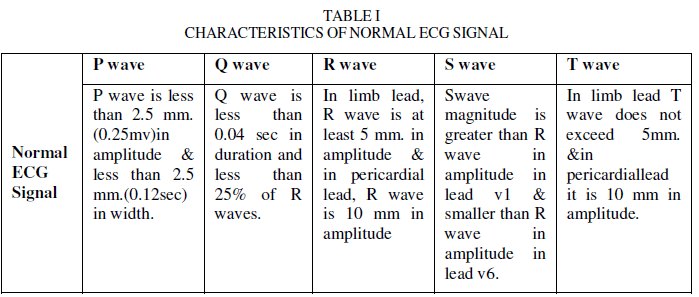 |
| The human heart consists of four chambers. The two upper chambers are atria (left and right) and two lower chambers are ventricles (left and right). Under healthy condition, these chambers beat in an organized order. Due to various types of cardiovascular diseases, some abnormalities are noticed. Electrocardiography (ECG) is a process, used to measure abnormal rhythms of the heart caused by electrolyte imbalances and the toxicity of certain drugs taken. When using this process, one side of electrodes is connected on specific locations of the body (chest, wrist and ankles) of a person and other side is connected to a recording machine. This recorder displays the electrical activity of the heart as a line picture on a graph or several graphs (each representing each of the leads); with time represented on the x-axis and voltage represented on y-axis i.e. the record shows a series of electrical waves that occurs during each beat of the heart. |
| In Fig 05: the ECG signal, which produce waves are known as P, Q, R, S, T and U waves. But the U weave is invisible most of the time [2].The characteristics of these waves help to detect the arrhythmias, conduction deficits and size or position of the chambers of the heart. ECG signals are very weak and the frequency range is 0.05-100Hz and most of the useful information present in the range of 0.5-45Hz [16] [17] [18] [19]. Electrocardiography is the first process which detects many heart related problems and is normally used to detect damaging of the heart and congenital heart diseases. |
C. Various Type Of Cardiovascular Diseases And It’s Remedy |
| It has been seen in the table 02: how the ECG signal wavelet changes due to various diseases .Also the cause and remedy has been depicted here. From this table a brief overview of listed disease can be made out. |
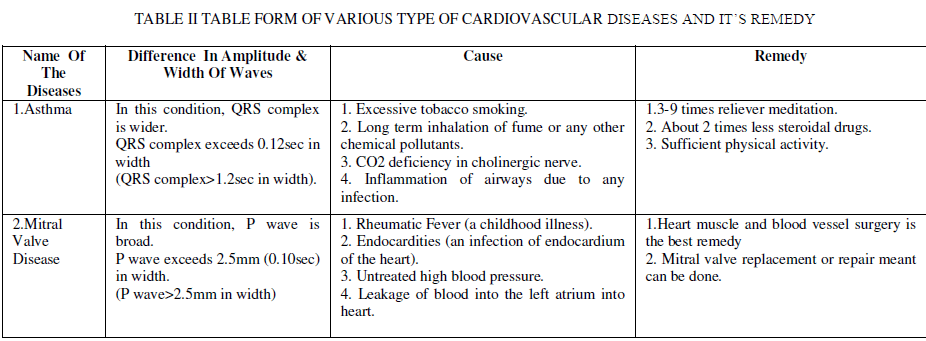 |
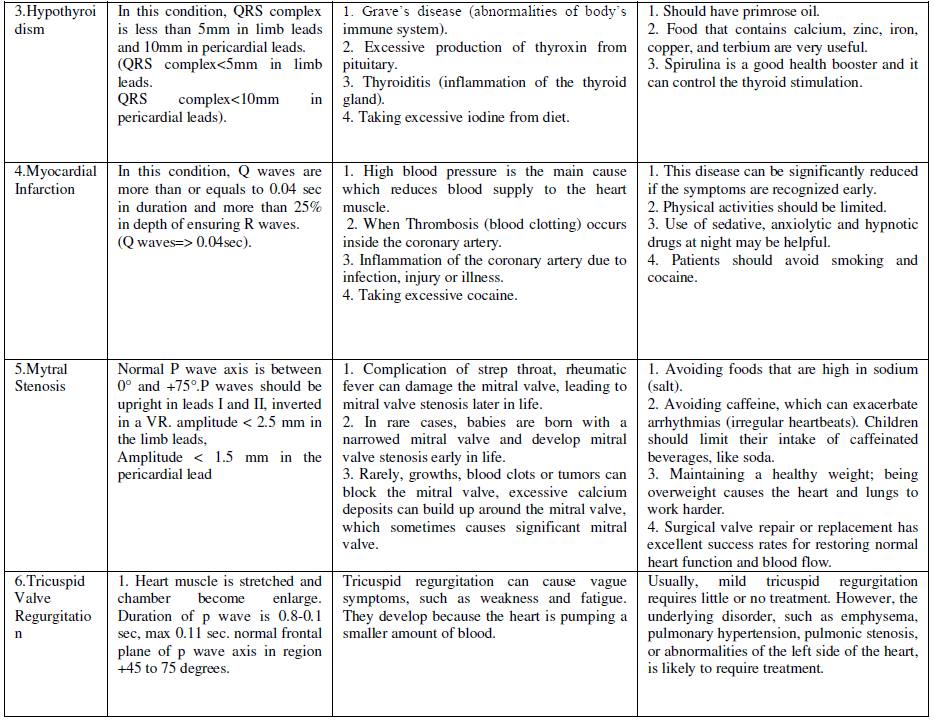 |
D. Medicinal approach |
| As it is known to all heart diseases is very complicated diseases, it should be consulted by a doctor. But the following medicines for respective diseases may be taken. Here some preliminary medicines are listed below- |
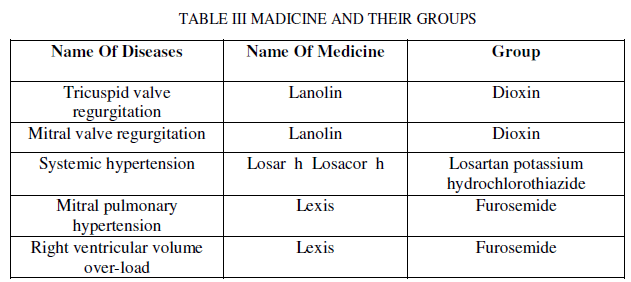 |
CONCLUSION |
| In conclusion of this paper, it has been seen that Electrocardiography (ECG) is a prime human physiological signal which can be used for various clinical applications to detect the rhythmic activity of human heart. Therefore the proper processing of ECG is very much important to diagnose the condition of heart. In this paper, it has been seen that what kind of heart diseases occur and how they can be measured by ECG. As well as how the precautions should be taken to prevent the heart diseases. In this project paper, an overview of various wave techniques of ECG signal is described. The paper helps to get an overview upon various heart diseases and their respective data of ECG signal, which also helps to detect the abnormalities of the heart. The tabular form of heart disease and its medicinal approach is the most valuable part, which helps to bring significant improvement. |
References |
|